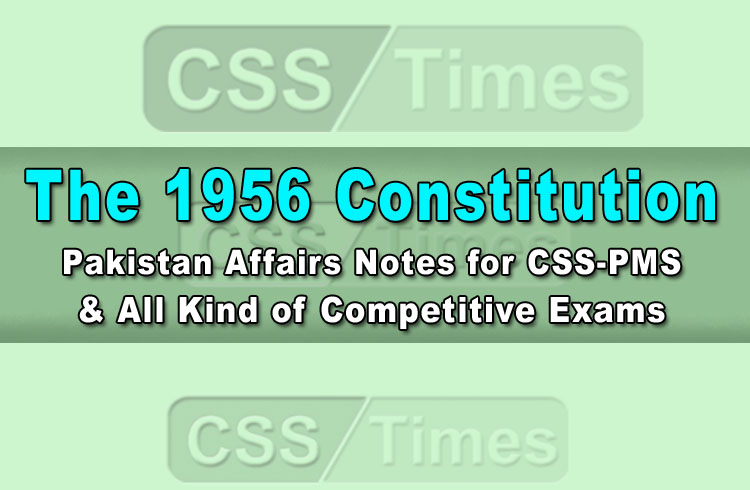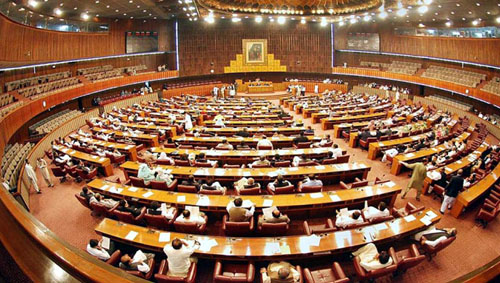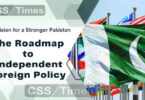The 1956 Constitution | Pakistan Affairs Notes for CSS-PMS
The Constitution of 1956 was passed after long deliberations. It replaced the Interim Constitution. It has 234 Articles and 6 Schedules. It declared that the name of the country would be the Islamic Republic of Pakistan.
There was clear impact of the Government of India Act, 1935 and the Interim Constitution.
Features
1: Parliamentary System
Executive Authority vested in the President who exercised it on the advice of the Prime Minister except in the matters he had discretion.
President had ceremonial functions and exercised limited powers.
The President would be of 45 years of age, Muslim and qualified to be a member of National Assembly.
He was to be elected by National Assembly (NA) and Provincial Assemblies.
Prime Minister
PM would be appointed by President. President could not remove him unless he was sure that PM did not enjoy the support of majority in the National Assembly. The President would be its sole judge. He could ask PM to show his support. Cabinet was collectively responsible to NA. PM was the head of government assisted by cabinet.
Check Complete Pakistan Affairs Notes for CSS-PMS
One House Parliament:
National Assembly was the only house of the parliament having a membership of 300 plus10 women seats. Principle of parity was observed for representation.
Method of direct elections was adopted for general seats. All legislative powers were rested with NA.
President could return, reject or sign the bills.
Regarding monetary bills of ordinary expenditure NA had all powers but they could not vote on Consolidated Fund List. Salaries of President, judges, federal service commission, etc. were to be paid through Consolidated Fund.
NA could control the Executive.
Check Also: Pakistan Affairs MCQs for CSS
2: Federal System
The constitution provided three lists: Federal, Provincial and Concurrent. There were two Provinces in the federation of Pakistan.
3: Provincial Structure:
At the provincial level there was elected Assembly. The Parliamentary System under the nominal headship of Governor. The real powers were given to Chief Ministers and his cabinet. Centre had some overriding powers and some Emergency powers too. They were Clause 191: Security or economic life was under threat for external or internal reasons. Clause 193: Constitutional crisis in provinces.
4: Independent Judiciary
At centre level the highest court was Supreme Court, then High Courts in provinces and subordinate courts were established.
Higher Courts have the power of Interpretation of the constitution. They could hear the disputes between governments. They were guardians of the Legal rights of the citizens.
5: Fundamental Rights
Civil and Political Rights were given to the people of Pakistan but they could be suspended in case of emergency.
6: Directive Principles of State Policy
These principles provided guidelines for policy making.
Principles of Objectives Resolution were included as preamble. The other principles included surety about Islamic practices, Welfare of people, non-discrimination, and fulfillment of basic needs, etc.
7: Islamic Character
- The name of the country was the Islamic Republic, Objectives Resolution was the Preamble.
- Other Islamic clauses were part of Directive Principles.
- No law can be made to violate Islamic principles and teachings.
- Existing laws would be brought in conformity with Islamic teachings.
- A Commission was to be appointed to examine the laws for bringing them in conformity.
- Whether a Law is Islamic or not, NA had to decide. The matter could be taken up with the Judiciary.
- Islam was not declared state religion.
- Islamic heritage and roots are combined with modern notions of governance and a moderate political system was adopted.
Working of the Constitution
No elections were held after the enforcement of elections. It was finally abrogated on October 7, 1958.
It worked from March 23, 1956 to October 7, 1958.
Check Other NOTES for Pakistan Affairs
- Unveiling Pakistan’s Nuclear Capabilities
- Allama Iqbal’s Contribution to Islamic Thought and Literature
- The Asian Development Bank’s Investment in Pakistan: A Review
- The Future of Pakistan’s Defence System: Prospects and Challenges
- The Politics of IMF Loans to Pakistan: Debates and Controversies
- A Vision for a Stronger Pakistan: The Roadmap to Independent Foreign Policy
- Reinventing a Nation: Reimagining Pakistan
- Understanding the Role of Caretaker Government in Pakistan’s Democratic Process
- The National Action Plan: An Overview
- Allama Iqbal | The Name — Not The Philosophy — Lives On









Very nice note’s thank you so much.
…
.